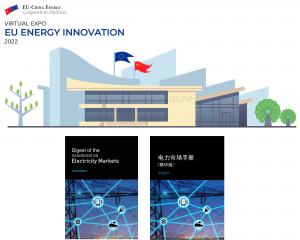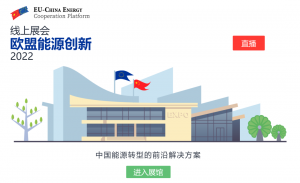
Opening of EU Energy Innovation Virtual Expo 8-10 November 2022
The EU Energy Innovation Virtual Expo, hosted by the EU-China Energy Cooperation Platform (ECECP), kicked off on 8 November 2022. Funded by the EU, supported by the European Union Chamber of Commerce in China (EUCCC) and promoted by EnergyPost, the exhibition showcases European companies who wish to introduce their innovative technologies in renewables, energy efficiency, energy storage, power grids and buildings to the Chinese market.
The three-day event brings together 15 European exhibitors from Denmark, Germany, Sweden, Finland, Norway, the Netherlands, Italy, Greece and Slovenia who are showcasing their innovative energy technologies, products and solutions in five separate virtual exhibition halls covering renewables, energy efficiency, energy storage, power grids and buildings. The Expo can be visited at www.euenergyinnovationexpo.com. Alongside internationally renowned companies such as Scania, Danfoss and Rolls-Royce, many outstanding European companies such as Elestor, JS Energy and Heliostorage are ready and willing to explore the Chinese market. The Expo offers them a ‘window’ through which to present their innovative energy solutions and case studies to the Chinese audience. In addition, a series of live online events and interviews are to be streamed from Europe throughout the three-day event; key industry experts and CEOs of participating companies will meet with the audience in a live forum to explore new opportunities for EU-China energy cooperation.
Chinese stakeholders have responded positively to the exhibition. According to ECECP, more than 20 Chinese enterprises have shown interest in the European technologies on show at the Expo. In addition, relevant departments in Hebei, Tianjin, Henan, Liaoning and Shandong provinces have arranged for local enterprises to participate in the online events and explore the possibility of future cooperation.
Energy innovation is an important engine for green development and combating climate change. At the launch event on 8 November 2022, Luis Schultz, international relations officer at DG ENER, highlighted the important role of EU-China cooperation in energy innovation in his opening speech.

‘China is at the forefront of the fight against climate change and the energy transition, and the EU has a wealth of experience and is looking forward to sharing with China. While both EU and China have set ambitious decarbonisation targets, goals and targets alone are not enough. What is most important for clean energy transition is the rapid and effective introduction of breakthrough energy technologies. In this regard, cooperation between the EU and China can play a crucial role and it is already recognised in the high level dialogue. This is precisely the reason why we organised this online exhibition, creating the opportunity for European and Chinese companies to cooperate.’ At the same time, Mr Schultz stressed that the cooporation in innovation can only take place if a level playing field is guaranteed for all actors and if investments and intellectual property rights are protected. ‘This is the only way that we can create a win-win situation for the EU and the Chinese partners.’
Russia’s invasion of Ukraine has cast a shadow over global energy markets and supply security, and EU-China cooperation on energy innovation takes on a special significance in this complex and turbulent situation.
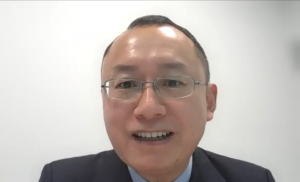
Mr Xu Zhonghua, chair of the Energy Working Group of the EU Chamber of Commerce in China (EUCCC), said: ‘In the energy industry, we are facing two big challenges: on one hand we need to work hard to ensure energy security that can power global sustainable development with safe, cheap, sustainable and low carbon energy products and solutions, on the other hand we need more than ever before to work together to decarbonise the whole life cycle of energy in the entire energy value chain, from production and transportation to final consumption, in the fight against climate change. So, innovation and global corporation are two important levers for us to secure these two important objectives. Both the EU and China play vital roles in global energy issues. This exhibition creates a unique opportunity that will surely increase opportunities in energy cooperation’.
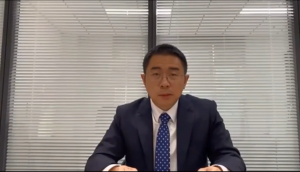
Fang Xiaosong, director of the International Business Department of Electric Power Planning and Engineering Institute, reviewed the extraordinary achievements of China’s clean energy transition in his welcome speech. However, as he stressed, China still faces many challenges in promoting green development and ensuring energy security. ‘Europe is one of the important incubators of innovation in the global energy sector and has accumulated a large number of advanced technologies in renewable energy, energy storage and smart energy. The EU and China share an interest in clean energy technology innovations and in their commercialisation, which offer great potential for cooperation. With many European enterprises presenting their advanced smart, integrated and clean technologies at the Expo, I believe that the two sides will take this occasion to deepen communication and create opportunities for cooperation.’
Launch of the Digest of the Handbook on Electricity Markets
The opening ceremony held on 8 November also featured a special session to launch of the Digest of the Handbook on Electricity Markets, in both Chinese and English, which was commissioned by ECECP.
The publication of the original Handbook on Electricity Markets in November 2021 could not have come at a better moment. Edited by Jean-Michel Glachant, Director of the Florence School of Regulation, Paul L. Joskow, Massachusetts Institute of Technology, and Michael G. Pollitt, University of Cambridge, the 600+ page book is an encyclopedia of the electricity market, bringing together contributions from some of the most brilliant thinkers and experts in the field of electricity markets.
The EU-funded special Digest of the Handbook presents this information in a highly condensed form so that its key points are available to busy decision-makers.
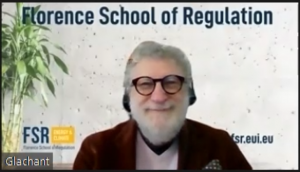
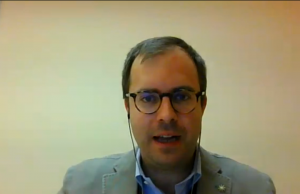
The China edition includes an extra chapter, ‘Takeaways from the Handbook on Electricity Markets in China,’ by Michael G. Pollitt, which highlights the relevance of the Handbook to China by discussing some of the key takeaways from each chapter and how they relate to the issues faced by China.

‘While Europe has much to teach China about how to organise the electricity market, the future of the electricity system depends on Chinese technology and it’s important that we recognise the mutual interdependence for the future of the electricity system globally between Europe and China,’ stressed Pollitt at the launch event.
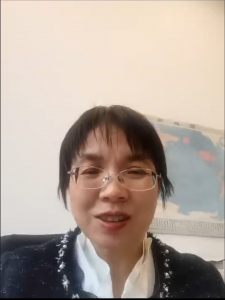
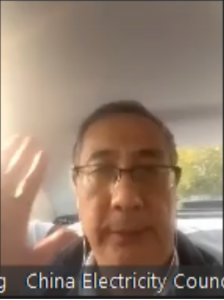

The production and publication of the Digest of Handbook on Electricity Markets, as well as the Virtual Expo of EU Energy Innovation, are funded by the EU Foreign Policy Instrument (FPI). In her concluding remarks, Mrs Viktorija Kaidalova, programme manager of the Asia-Pacific Regional Team of the Service for Foreign Policy Instrument, was positive about publication of the Digest. ‘It is the first of its kind and is a remarkable tool which will facilitate work and exchanges of decision makers and professionals in the field and keep them informed with the knowledge in order to advance in the clean energy transition.’ She expressed her confidence that the Virtual Expo of EU Energy Innovation will create opportunities for new business prospects for innovative companies from the EU to help China achieve its ambitious goals for the clean energy transition and for carbon neutrality.
Digest of the Handbook on Electricity Markets – China Edition
